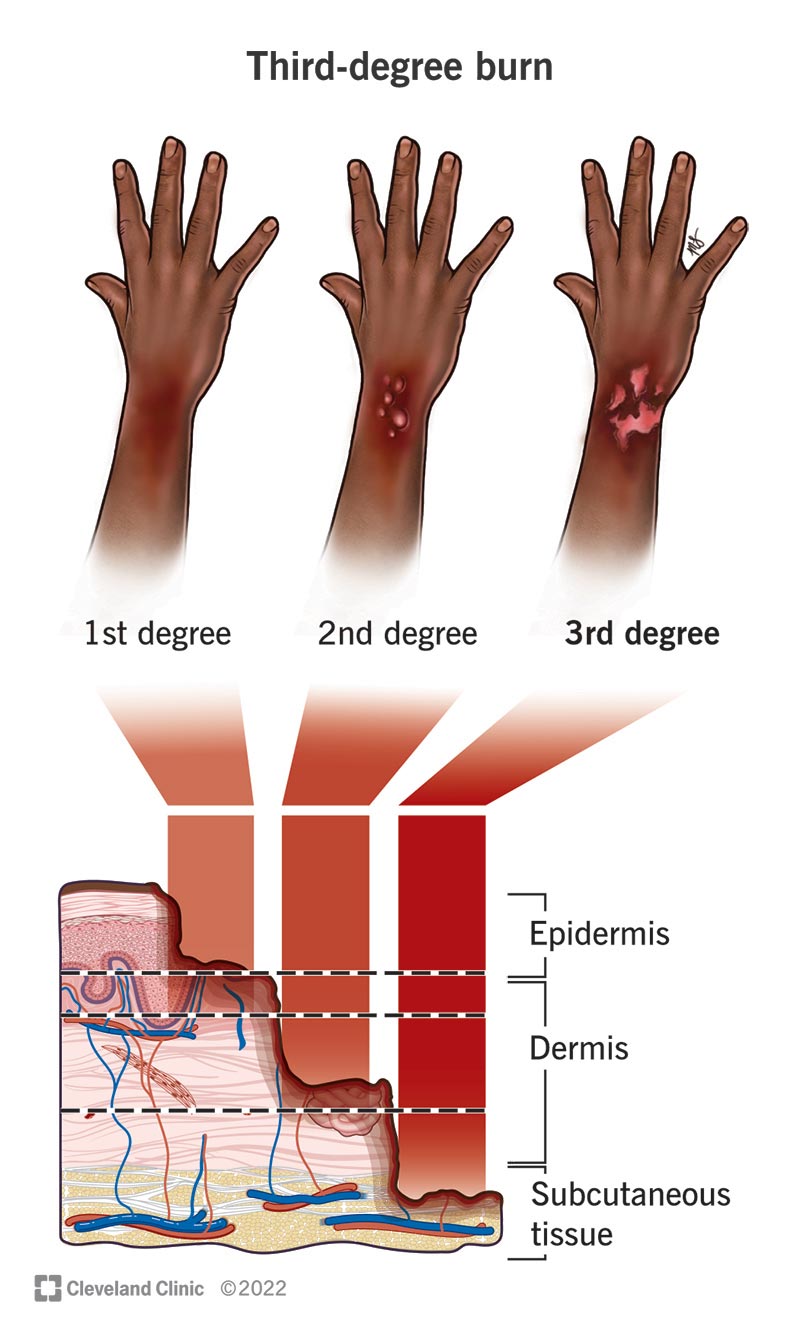A third-degree burn destroys your first three layers of skin and fatty tissue. A third-degree burn may not immediately hurt, but you’ll notice your skin is charred-black, dry and leathery. This type of burn is serious and requires treatment by a healthcare provider. Your healing time varies based on the size and location of the burn.
Advertisement
Cleveland Clinic is a non-profit academic medical center. Advertising on our site helps support our mission. We do not endorse non-Cleveland Clinic products or services. Policy

Third-degree burns are a serious type of burn that requires immediate medical attention. A burn is damage to your skin or underlying tissue due to extreme temperatures, a chemical or a light source.
Advertisement
Cleveland Clinic is a non-profit academic medical center. Advertising on our site helps support our mission. We do not endorse non-Cleveland Clinic products or services. Policy
A third-degree burn damages the top layer of your skin (epidermis), the middle layer of your skin (dermis) and the layer of fat underneath your skin (hypodermis). A third-degree burn can also damage your sweat glands, hair follicles and nerve endings.
You won’t feel immediate pain if you have a third-degree burn because the burn destroyed your nerves. This can make you believe that your burn isn’t serious, but it is, and you should see a healthcare provider for treatment.
Features of a third-degree burn include:
A third-degree burn won’t blanch or turn white temporarily when you press on your affected skin. Blanching is common for first- and second-degree burns.
A third-degree burn will likely have features of a second-degree burn around it, including:
You can get a third-degree burn anywhere on your body depending on what caused the burn. Common locations for a third-degree burn include your:
The number of each degree of burn identifies how many layers of damage your body has, including:
Advertisement
While less common, extremely serious burns can extend past three degrees and could include:
If you have a first- or second-degree burn that’s less than 3 inches in diameter or a burn that’s not on your face, you can treat your burn at home. Serious burns or large burns include third-degree burns and up. See a healthcare provider if you have a serious burn.
The same things that can cause a first- and second-degree burn can cause a third-degree burn. The difference is how long your body met a heat, chemical or light source that caused damage, or the intensity of the source of the burn. The more intense the damage source and/or the longer your body interacts with a cause of a burn, the more damage you’ll have.
Common causes of a third-degree burn include:
If you have a third-degree burn, visit an emergency department for treatment. While you may not feel pain, the damage to your skin and tissues is severe and requires medical attention. Treatment varies for a third-degree burn based on size and location. A healthcare provider may treat a third-degree burn by:
Advertisement
Yes, a third-degree burn will likely cause a scar on your skin. If you follow your healthcare provider’s instructions on how to take care of your burn, your scar could be smaller than expected. Scars can fade over time.
Burns are usually preventable. To prevent them, or at least reduce the risk of them happening, you can:
It will take at least three weeks for a third-degree burn to heal if it’s small. Larger third-degree burns can take a couple of years to heal completely. Your healthcare provider can help you understand how long your healing will take based on the size and location of your burn.
If you have a third-degree burn, visit the emergency room. Third-degree burns should always receive treatment from a healthcare provider and you shouldn’t attempt to treat a third-degree burn at home. If you’re unsure what type of burn you have, see a healthcare provider.
Advertisement
A third-degree burn is a serious injury that requires immediate medical attention. Don’t wait to visit the emergency room after a third-degree burn, as they can cause shock and be life-threatening if left untreated. You may not immediately feel pain from a third-degree burn, which can make you think it isn’t serious, but it is. If you’re unsure what type of burn you have, see a healthcare provider as a precaution.
Advertisement
Every day, people see your skin, hair and nails. At Cleveland Clinic, our expert and caring dermatology team will make sure they’re healthy and strong.

Last reviewed on 12/13/2022.
Learn more about the Health Library and our editorial process.